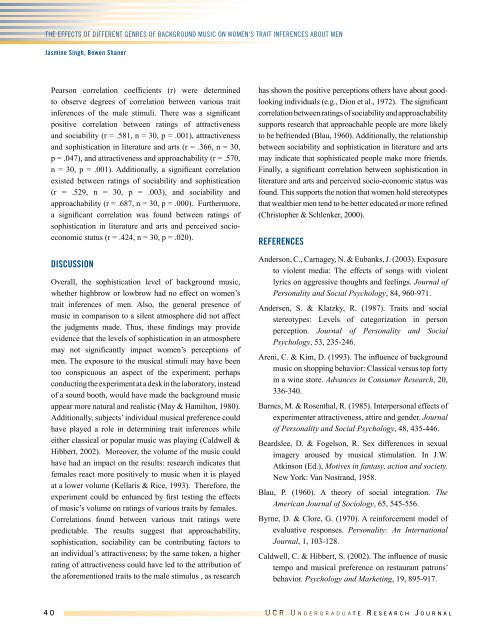Undergraduate Research Journal
Undergraduate Research Journal
Undergraduate Research Journal
You also want an ePaper? Increase the reach of your titles
YUMPU automatically turns print PDFs into web optimized ePapers that Google loves.
The Effects of Different Genres of Background Music on Women's Trait Inferences About Men<br />
Jasmine Singh, Bowen Shaner<br />
Pearson correlation coefficients (r) were determined<br />
to observe degrees of correlation between various trait<br />
inferences of the male stimuli. There was a significant<br />
positive correlation between ratings of attractiveness<br />
and sociability (r = .581, n = 30, p = .001), attractiveness<br />
and sophistication in literature and arts (r = .366, n = 30,<br />
p = .047), and attractiveness and approachability (r = .570,<br />
n = 30, p = .001). Additionally, a significant correlation<br />
existed between ratings of sociability and sophistication<br />
(r = .529, n = 30, p = .003), and sociability and<br />
approachability (r = .687, n = 30, p = .000). Furthermore,<br />
a significant correlation was found between ratings of<br />
sophistication in literature and arts and perceived socioeconomic<br />
status (r = .424, n = 30, p = .020).<br />
Discussion<br />
Overall, the sophistication level of background music,<br />
whether highbrow or lowbrow had no effect on women’s<br />
trait inferences of men. Also, the general presence of<br />
music in comparison to a silent atmosphere did not affect<br />
the judgments made. Thus, these findings may provide<br />
evidence that the levels of sophistication in an atmosphere<br />
may not significantly impact women’s perceptions of<br />
men. The exposure to the musical stimuli may have been<br />
too conspicuous an aspect of the experiment; perhaps<br />
conducting the experiment at a desk in the laboratory, instead<br />
of a sound booth, would have made the background music<br />
appear more natural and realistic (May & Hamilton, 1980).<br />
Additionally, subjects’ individual musical preference could<br />
have played a role in determining trait inferences while<br />
either classical or popular music was playing (Caldwell &<br />
Hibbert, 2002). Moreover, the volume of the music could<br />
have had an impact on the results: research indicates that<br />
females react more positively to music when it is played<br />
at a lower volume (Kellaris & Rice, 1993). Therefore, the<br />
experiment could be enhanced by first testing the effects<br />
of music’s volume on ratings of various traits by females.<br />
Correlations found between various trait ratings were<br />
predictable. The results suggest that approachability,<br />
sophistication, sociability can be contributing factors to<br />
an individual’s attractiveness; by the same token, a higher<br />
rating of attractiveness could have led to the attribution of<br />
the aforementioned traits to the male stimulus , as research<br />
has shown the positive perceptions others have about goodlooking<br />
individuals (e.g., Dion et al., 1972). The significant<br />
correlation between ratings of sociability and approachability<br />
supports research that approachable people are more likely<br />
to be befriended (Blau, 1960). Additionally, the relationship<br />
between sociability and sophistication in literature and arts<br />
may indicate that sophisticated people make more friends.<br />
Finally, a significant correlation between sophistication in<br />
literature and arts and perceived socio-economic status was<br />
found. This supports the notion that women hold stereotypes<br />
that wealthier men tend to be better educated or more refined<br />
(Christopher & Schlenker, 2000).<br />
REFERENCES<br />
Anderson, C., Carnagey, N. & Eubanks, J. (2003). Exposure<br />
to violent media: The effects of songs with violent<br />
lyrics on aggressive thoughts and feelings. <strong>Journal</strong> of<br />
Personality and Social Psychology, 84, 960-971.<br />
Andersen, S. & Klatzky, R. (1987). Traits and social<br />
stereotypes: Levels of categorization in person<br />
perception. <strong>Journal</strong> of Personality and Social<br />
Psychology, 53, 235-246.<br />
Areni, C. & Kim, D. (1993). The influence of background<br />
music on shopping behavior: Classical versus top forty<br />
in a wine store. Advances in Consumer <strong>Research</strong>, 20,<br />
336-340.<br />
Barnes, M. & Rosenthal, R. (1985). Interpersonal effects of<br />
experimenter attractiveness, attire and gender. <strong>Journal</strong><br />
of Personality and Social Psychology, 48, 435-446.<br />
Beardslee, D. & Fogelson, R. Sex differences in sexual<br />
imagery aroused by musical stimulation. In J.W.<br />
Atkinson (Ed.), Motives in fantasy, action and society.<br />
New York: Van Nostrand, 1958.<br />
Blau, P. (1960). A theory of social integration. The<br />
American <strong>Journal</strong> of Sociology, 65, 545-556.<br />
Byrne, D. & Clore, G. (1970). A reinforcement model of<br />
evaluative responses. Personality: An International<br />
<strong>Journal</strong>, 1, 103-128.<br />
Caldwell, C. & Hibbert, S. (2002). The influence of music<br />
tempo and musical preference on restaurant patrons’<br />
behavior. Psychology and Marketing, 19, 895-917.<br />
4 0 U C R U n d e r g r a d u a t e R e s e a r c h J o u r n a l














